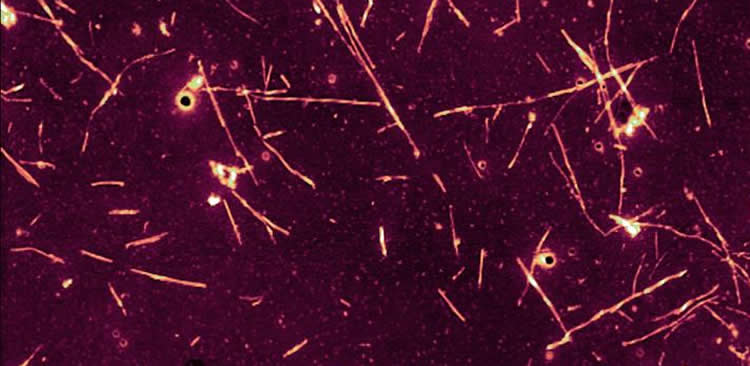Summary: Researchers detail the complex interaction between alpha synuclein and the prion protein PrPc.
Source: SISSA.
New research has proven the existence of an important interaction between the molecules involved in the two types of pathologies.
Parkinson’s disease and prion diseases are very different from each other in regards to both origins and course. A group of researchers, headed by Professor Giuseppe Legname, has discovered an unexpected and important link between the two pathologies.
According to the study recently published Scientific Reports, the link is a result the complex interaction between two different proteins present in our nerve cells: α-synuclein, in its aggregated form, and the prion protein PrPC, the molecule which is responsible Creuzfeldt Jacob disease.
The presence of α-synuclein deposits in brain cells is typical of diseases technically called synucleinopathies, including Parkinson’s disease, dementia with Lewy bodies and multiple system atrophy. However, the modalities according to which these aggregates form and spread were unknown. The study reports α-synuclein actually makes use of the action of the prion protein to spread and deposit in the brain. This seems to favour the formation of these deposits and their spreading among brain cells.

But that’s not all. While the activity of the prion protein seems to support the development of synucleopathies, α-synuclein deposits seem to slacken the course of prion diseases. The research has proven that α-synuclein fibrils block the deposit of prions in nerve cells, thus preventing their replication. This surprising effect is corroborated by further evidence already found in the pathology: in fact, the course of the disease results to be slower in patients affected by prion diseases presenting α-synuclein deposits in nerve cells.
This study – whose practical implications are already being considered – benefitted from the participation of researchers also from Fondazione Carlo Besta in Milan, ELETTRA Sincrotrone in Trieste and the University of Trieste.
Source: Donato Ramani – SISSA
Image Source: NeuroscienceNews.com image is credited to Denis Scaini.
Original Research: Full open access research for “α-Synuclein Amyloids Hijack Prion Protein to Gain Cell Entry, Facilitate Cell-to-Cell Spreading and Block Prion Replication” by Suzana Aulić, Lara Masperone, Joanna Narkiewicz, Elisa Isopi, Edoardo Bistaffa, Elena Ambrosetti, Beatrice Pastore, Elena De Cecco, Denis Scaini, Paola Zago, Fabio Moda, Fabrizio Tagliavini & Giuseppe Legname in Scientific Reports. Published online August 30 2017 doi:10.1038/s41598-017-10236-x
[cbtabs][cbtab title=”MLA”]SISSA “Molecular Link Between Parkinson’s and Prion Diseases Discovered.” NeuroscienceNews. NeuroscienceNews, 14 September 2017.
<https://neurosciencenews.com/parkinsons-prion-diseases-7486/>.[/cbtab][cbtab title=”APA”]SISSA (2017, September 14). Molecular Link Between Parkinson’s and Prion Diseases Discovered. NeuroscienceNews. Retrieved September 14, 2017 from https://neurosciencenews.com/parkinsons-prion-diseases-7486/[/cbtab][cbtab title=”Chicago”]SISSA “Molecular Link Between Parkinson’s and Prion Diseases Discovered.” https://neurosciencenews.com/parkinsons-prion-diseases-7486/ (accessed September 14, 2017).[/cbtab][/cbtabs]
Abstract
α-Synuclein Amyloids Hijack Prion Protein to Gain Cell Entry, Facilitate Cell-to-Cell Spreading and Block Prion Replication
The precise molecular mechanism of how misfolded α-synuclein (α-Syn) accumulates and spreads in synucleinopathies is still unknown. Here, we show the role of the cellular prion protein (PrPC) in mediating the uptake and the spread of recombinant α-Syn amyloids. The in vitro data revealed that the presence of PrPC fosters the higher uptake of α-Syn amyloid fibrils, which was also confirmed in vivo in wild type (Prnp+/+) compared to PrP knock-out (Prnp−/−) mice. Additionally, the presence of α-Syn amyloids blocked the replication of scrapie prions (PrPSc) in vitro and ex vivo, indicating a link between the two proteins. Indeed, whilst PrPC is mediating the internalization of α-Syn amyloids, PrPSc is not able to replicate in their presence. This observation has pathological relevance, since several reported case studies show that the accumulation of α-Syn amyloid deposits in Creutzfeldt-Jakob disease patients is accompanied by a longer disease course.
“α-Synuclein Amyloids Hijack Prion Protein to Gain Cell Entry, Facilitate Cell-to-Cell Spreading and Block Prion Replication” by Suzana Aulić, Lara Masperone, Joanna Narkiewicz, Elisa Isopi, Edoardo Bistaffa, Elena Ambrosetti, Beatrice Pastore, Elena De Cecco, Denis Scaini, Paola Zago, Fabio Moda, Fabrizio Tagliavini & Giuseppe Legname in Scientific Reports. Published online August 30 2017 doi:10.1038/s41598-017-10236-x






